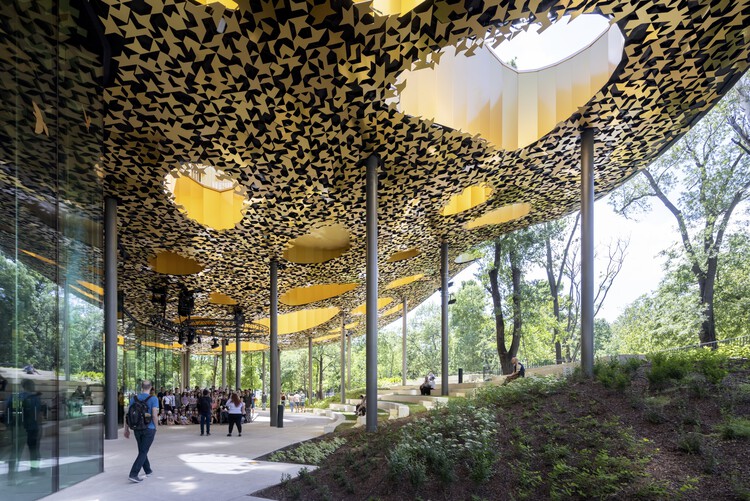
-
Architects: Sou Fujimoto Architects
- Area: 9000 m²
- Year: 2021
-
Lead Architect: Sou Fujimoto
-
Architect of Record: Bence Varga

Text description provided by the architects. The House of Hungarian Music, in the heart of the City Park of Budapest, is not only a museum but a larger vision encompassing past and future, people and culture, nature, and the sciences of music. It is not about displaying but inviting in, going away from simple contemplation to suggest participation and interactions. The essence of sound and music, hearing, can be brought in much deeper ways. Away from the conventional exhibition spaces, classrooms, or event halls, we chose to let architecture cradle the visitors along their way. With no clear path, pedestrians meander around the museum, as they would do around the park, invading the space like a continuous flow whose intensity varies along with the days, just as sound permeates space, bouncing around surfaces, running along the walls.



The House of Hungarian Music is also the vision of a 21st-century museum, highly integrated into the environment by all means. Ecologically friendly as well as aesthetically, fitting carefully to the landscape and the soul of the park, this vision of the 21st century put the emphasis on the act of meeting and sharing, regardless of the reasons that brought people to this place: to study, listen, perform, play or work, everyone has a place to teach and to learn. The project, by its architectural qualities, and by letting the environment penetrate its heart, becomes a symbol of today’s open borders, physical or electronic freedom of traveling and communicating all around the world.



We were astonished by the abundance of trees in the City Park where the museum is located. They gather to create a continuous and dense forest, sometimes drawn away from each other to open up and let people see the sky. A piece of nature filled with age and history, yet with a subtle semblance of wildness, varying along the seasons. We were inspired by the room shaped by the trees, and how their dense and generous foliage covers and protects, letting, sometimes, sun rays reach the ground.

Our project finds its shape naturally among the trees’ crowns. Its circular volume levitates gently, turned to every direction, freeing out the ground floor to welcome people from all around, while its perforations let the natural light through, just like the sun rays breaching between the leaves of a forest.


Activities such as concerts or various events take place under the floating volume, for everyone to see and listen, attracting large crowds to meet and share music. This open ground floor, where limits between inside and outside are fading away, is thought of as the continuity of the landscape whose green areas radiate away, as the waves of sound. A visitor wanders freely among the museum, between the trees, along the curves of the walls, up and down the large spiral staircase, cradled around by the vibrations of the spaces, and by the soft variations of the sunlight. Surprising encounters punctuate one’s route, just as the unexpected notes of a melody, following an uninterrupted movement, up, down, around, inside, outside, the same flow binding softly together museum, park, people, and music, making the visitor experience unique.























